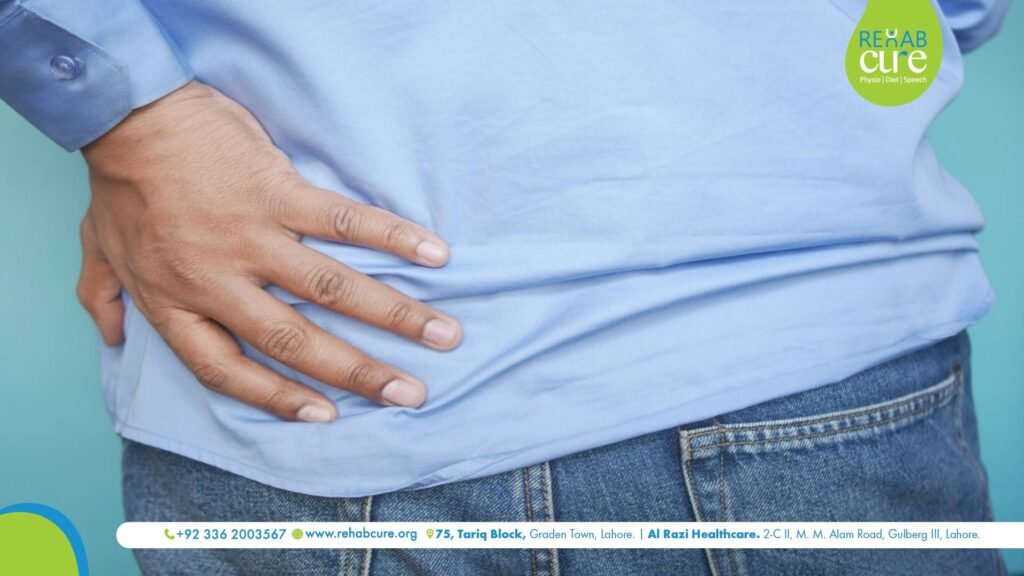Sciatica Pain and Symptoms
Sciatica is a common and frequent disease in everyday life. So that more and more people fall victim to it. Sciatica is not an independent disease but is caused by a group of clinical syndromes caused by various diseases.
Sciatica is an inflammation of the sciatic nerve, which Works from the back to the leg. Feeding the sciatic nerve. The muscles of the back of the thigh (hamstrings), down the Leg, ankle, and foot. It also gives sensation to the skin. The back of the thigh, the outside of the leg, and the bottom and inside Feet part. There may be swelling of this nerve.
Sciatica Pain Treatment in Pakistan
RehabCure provides you sciatica pain treatment in Pakistan with advanced techniques. We are located at 75 Tariq block, Garden town, Lahore, Pakistan. Call us 03362003567
Common signs and symptoms
- Pain in the back of the thigh, usually traveling below the thigh.
- Can be worse than knee bending, sneezing, coughing,
- Stress, or prolonged sitting
- Numbness or weakness that affects the thigh, lower leg, ankle, or foot
- Occasionally, back or hip pain
Reasons
- Sciatica is caused by inflammation of the sciatic nerve.
- As a result of irritation from various sources, which
Involved in:
- Trauma
- A torn disk
- Arthritis of the spinal cord
- Spondylolisthesis (vertebral slipping)
- Pelvic muscle pressure (hamstring, piriformis)
- Sat on the purse for a long time
Factors that Increase Risk:
- Any sport that causes downward or downward pressure.
- Spine, usually football, weight lifting, equestrian sports, bowling, tennis, jogging, track, racquetball.
- Or gymnastics
- Poor physical conditioning (strength, flexibility)
- Insufficient warm-up before practice or play
- Family history of back pain or disc herniation
- Lumbar surgery, especially fusion
- Pre-existing spondylolisthesis
- Poor mechanics with lifting
- Prolonged sitting, especially with poor mechanics
Precautions:
- Use appropriate posture and proper technique while sitting.
- When lifting
- Properly warm-up and stretch before exercising.
- Competition
- Maintain proper conditioning, including the back.
- And hamstring flexibility, muscle strength and endurance, and cardiovascular fitness.
- Maintain ideal body weight.
- If you have ever had a back injury, avoid doing anything violent.
- Physical activity in which the body needs to bend.Out of control
General Treatment:
- Initial treatment consists of rest, medication, and ice.
- To relieve pain and inflammation. Improvement exercises.
- Strength and flexibility and proper back mechanics
- Are important, as is avoiding any activity.
- Create symptoms. Consult a physical therapist or Athletic trainers may be recommended for exercises, back mechanics education, and possibly others.
- Treatments, such as transcutaneous electronic nerves Stimulation (TENS) or ultrasound.
- Biofeedback may also be recommended.
- Occasionally.
Epidural steroid injections or oral steroids may be offered to reduce nerve inflammation.
- For patients Who suffer from symptoms despite conservatism.
Sciatica Pain Medicine in Pakistan
Non-steroidal anti-inflammatory drugs, e.g. Aspirin and ibuprofen (do not take 7 days earlier). Surgery), or other minor pain relievers, such as acetaminophen, are often recommended. Take them as directed by your doctor, and contact your doctor immediately if there is any bleeding, upset stomach, or symptoms. For an allergic reaction, topical analgesic ointments can be helpful.
Lower Back Pain Medicine in Pakistan
Strong pain relievers and muscle relaxants may be prescribed as needed. Use them only as directed, and Get just what you need. Do not use any heavy. Run or operate machinery while taking these medicines. Injections of corticosteroids into the epidural space Can be given to reduce spinal inflammation, Although this is not usually done for serious wounds. Oral steroids may be given to reduce inflammation, Although this is not usually done for serious wounds.
Heat and cold
- The common cold is used to relieve pain and reduce inflammation.
- For severe and chronic cases. Apply for it 10 to 15 minutes every 2 to 3 hours as needed
- Immediately after any activity that disturbs you.
- Symptoms Use ice packs or ice massages.
- Heat can be used before stretching.
- Strengthen your doctor’s recommended activities,
- Physical therapist, or athletic trainer. Use a hot pack Or a hot soak.
Range Of Motion And Stretching Exercises:
The range of motion and stretching exercises that you need to do is usually set to one.
Individual basis, Some people respond better to bending (pulling their knees towards their chest), while others Give a better answer to the extension (arc your back). The important thing to remember is that if any exercise Moving, stretching, or strengthening – causes pain.
Spread from your back to your hips. Or legs, stop exercising immediately the aim. The intensity of these exercises must be reduced. And the size of your pain area. These are just some of the goal-setting shareware that you can use. To start your recovery program, until you see, a physical therapist, or athletic trainer Again, or until your symptoms go away.
Twist and Extensive exercises are offered here, but This should be explained by the exercises that are suitable for you. Your therapist, physical therapist, or athletic trainer Before you begin. Please note: Flexible tissue is more tolerant of pressure over it. There should be a sense of light. If the pain or other symptoms go away. Back to your hips or legs, stop exercising.
Get an expert opinion for your customized problem from our doctors. Thanks for reading.

